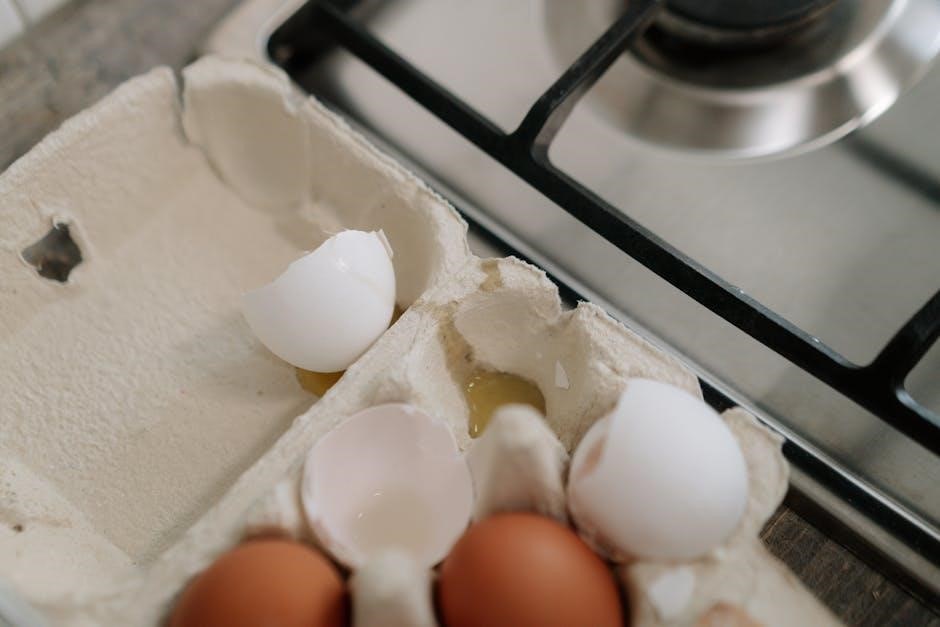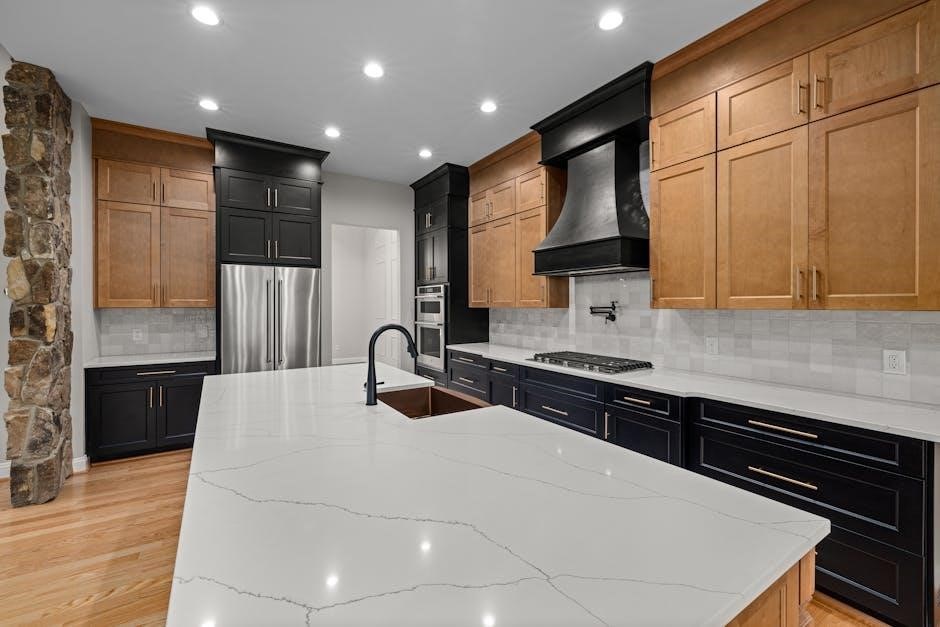Rocket stove heater plans provide detailed instructions for building efficient, eco-friendly heating solutions. These designs optimize fuel use, reduce emissions, and offer cost-effective alternatives for sustainable home heating.
1.1 What is a Rocket Stove Heater?
A rocket stove heater is a highly efficient, eco-friendly heating system that uses advanced insulation and combustion principles to maximize heat output while minimizing fuel consumption. It operates by burning wood or other biomass in a controlled, oxygen-rich environment, producing intense heat that is stored and released slowly through thermal mass. Unlike traditional wood stoves, rocket heaters achieve exceptional efficiency, often using 80-90% less fuel to heat the same space, making them a sustainable and cost-effective alternative for home heating.
1.2 Importance of Using Rocket Stove Heater Plans
Using rocket stove heater plans is essential for constructing a safe, efficient, and environmentally friendly heating system. These plans provide precise instructions, ensuring optimal performance and compliance with safety standards. They help minimize fuel consumption and emissions, making the heater eco-friendly. Additionally, the plans often include detailed materials lists and step-by-step guides, reducing costs and simplifying the building process. By following these plans, you can create a reliable, sustainable heating solution tailored to your needs, ensuring both effectiveness and long-term savings.

Benefits of Rocket Stove Heaters
Rocket stove heaters offer high efficiency, low fuel consumption, and reduced emissions, making them eco-friendly. They provide cost-effective heating solutions while minimizing environmental impact, ensuring sustainability.
2.1 High Efficiency and Low Fuel Consumption
Rocket stoves are renowned for their exceptional efficiency, often consuming as little as 1/10th of the fuel compared to traditional wood stoves. This is achieved through advanced combustion chamber designs that ensure complete fuel burn, minimizing waste and maximizing heat output; The insulated chambers and precise airflow systems enhance thermal performance, allowing for significant fuel savings. This high efficiency not only reduces operational costs but also lowers emissions, making rocket stoves an eco-friendly and cost-effective heating solution. Their design ensures optimal energy utilization, providing consistent and reliable heat with minimal resource consumption.
2.2 Environmental Benefits
Rocket stove heaters offer significant environmental benefits due to their high efficiency and low emissions. By burning fuel almost completely, they produce minimal smoke and pollutants compared to traditional stoves. This reduces greenhouse gas emissions and minimizes environmental impact. Additionally, their efficient design requires less wood, helping to conserve forests and reduce deforestation. The use of recycled materials in construction further enhances their eco-friendly profile, making rocket stoves a sustainable and responsible heating option for environmentally conscious users.
2.3 Cost-Effectiveness
Rocket stove heaters are highly cost-effective due to their efficient design and minimal fuel consumption. They use significantly less wood compared to traditional stoves, reducing long-term expenses. The plans often include affordable materials, such as recycled steel and brick, making construction budget-friendly. Additionally, the heaters’ durability and low maintenance requirements further lower ownership costs. With downloadable PDF guides offering clear instructions, building a rocket stove becomes an economical alternative to conventional heating systems, providing substantial savings over time.

Design and Construction Overview
Rocket stove heaters are built using detailed plans that outline layer-by-layer brick layouts, precise dimensions, and essential materials. These designs ensure efficient combustion and heat retention.
3.1 Key Design Principles
The core of rocket stove heater design lies in optimizing airflow, insulation, and heat exchange. Properly sized combustion chambers ensure complete fuel burning, while insulated ducts maximize heat retention.
3.2 Materials and Tools Needed
Building a rocket stove heater requires specific materials and tools. Essential materials include firebrick, insulation, steel for the combustion chamber, and refractory mortar. Tools like a saw, drill, trowel, and measuring tape are necessary for precise construction. Ensure all components align with the PDF plans for optimal performance and safety. Proper materials and tools are crucial for achieving the desired efficiency and durability of the heater.
3.3 Safety Considerations
Safety is paramount when building and using a rocket stove heater. Ensure proper ventilation to prevent carbon monoxide buildup and install a chimney or flue according to PDF plans. Regular inspection of combustion chambers and heat exchangers is essential to avoid cracks or damage. Keep flammable materials away and maintain a safe distance from walls. Testing the heater before full use ensures it operates correctly. Adhering to safety guidelines guarantees efficient and hazard-free performance, aligning with the design principles outlined in the plans.
Detailed Rocket Stove Heater Plans
Detailed plans include layer-by-layer brick layouts, precise dimensions, and comprehensive materials lists. PDF guides provide step-by-step instructions for building efficient rocket stove heaters at home.
4.1 Layer-by-Layer Brick Layout
The layer-by-layer brick layout is a critical component of rocket stove heater plans. Each layer is carefully designed to ensure efficient combustion and heat retention. The combustion chamber, heat lab, and insulation layers are precision-placed to maximize performance. PDF guides provide detailed visual layouts, showing the exact placement of each brick and material. This step-by-step approach ensures that even novice builders can construct a functional and efficient rocket stove heater. Proper alignment and spacing are emphasized to maintain safety and optimal heating capabilities.
4.2 Dimensions and Measurements
Rocket stove heater plans provide precise dimensions and measurements to ensure optimal performance. The combustion chamber, heat riser, and ducting systems are carefully sized for efficient heat exchange. PDF guides offer detailed diagrams and specifications, including both Imperial and Metric measurements. Dimensions for the firebox, insulation layers, and exterior casing are provided to ensure proper fit and functionality. These measurements are crucial for maintaining airflow, combustion efficiency, and safety. By following these specifications, builders can construct a stove that performs reliably and effectively.
4.3 Comprehensive Materials List
A comprehensive materials list is essential for building a rocket stove heater. Common materials include firebrick for the combustion chamber, insulation materials like vermiculite or ceramic wool, and steel for the stovepipe and dampers. Additionally, sand, clay, and refractory mortar are often used for construction. Detailed PDF plans specify quantities and types of materials needed, ensuring builders can source everything required. This list is tailored to ensure durability, efficiency, and safety, covering both small-scale and full-size rocket stove projects. Measurements are provided in both Imperial and Metric systems for clarity.

Building the Rocket Stove Heater
Constructing a rocket stove heater involves assembling components like firebrick, insulation, and steel pipe. Clear PDF plans guide the process, ensuring efficiency and safety in every step.

5.1 Preparing the Site
Preparing the site is crucial for a successful rocket stove heater installation. Ensure the area is flat, dry, and clear of flammable materials. Choose a location near a chimney or ventilation point for proper airflow. Measure the space to accommodate the stove’s dimensions, ensuring enough room for safe operation. Protect the floor with heat-resistant material to prevent damage. Check local building codes and safety regulations before starting. Clear the area of debris and ensure all tools and materials are within reach for efficient assembly. Use the PDF plans as a guide to mark the layout accurately.
5.2 Assembling the Stove Components
Assembling the stove components requires precision and adherence to the PDF plans. Start by positioning the combustion chamber and heat exchanger according to the design. Use a level to ensure proper alignment. Connect the fuel feed and chimney components securely, ensuring airtight seals. Follow the layer-by-layer brick layout for the stove’s core structure. Use heat-resistant mortar to bond the bricks, and allow each layer to set before proceeding. Refer to the materials list for specific tools, such as a trowel or welding equipment, depending on the design. Double-check all connections for safety and efficiency before moving on.
5.3 Installing Insulation
Installing insulation is crucial for maximizing the efficiency and safety of your rocket stove heater. Use high-temperature insulation materials like ceramic wool or vermiculite around the combustion chamber and heat exchanger. Line the inside of the stove with refractory insulation to retain heat and protect the outer layers. Ensure proper coverage by following the PDF plans closely. Apply insulation around the burn tunnel and riser to minimize heat loss. Secure all insulation with heat-resistant mortar for a durable finish. Proper insulation ensures optimal performance and longevity of the heater.

Rocket Mass Heater Specifics
Rocket mass heaters use thermal mass to store and release heat efficiently. They burn wood efficiently, producing significant heat with minimal fuel, ideal for eco-friendly, cost-effective heating solutions.
6.1 Understanding Mass Heater Technology
Rocket mass heater technology combines efficient combustion with thermal mass storage. It uses a rocket stove to burn fuel cleanly, capturing and storing heat in materials like brick or stone. This design allows for slow, consistent heat release, maximizing energy efficiency. The system reduces fuel consumption and emissions, making it an eco-friendly option. Proper insulation and airflow are critical for optimal performance. This technology is ideal for sustainable, low-cost heating solutions, offering significant advantages over traditional wood-burning stoves.
6.2 Differences from Traditional Wood Stoves
Rocket stove heaters differ significantly from traditional wood stoves due to their advanced combustion technology. They achieve higher efficiency by burning fuel more completely, resulting in lower emissions and reduced wood consumption. Unlike conventional stoves, rocket heaters use thermal mass to store and release heat gradually, providing longer-lasting warmth. This design also minimizes smoke and pollutants, making them a cleaner and more sustainable option for home heating compared to older, less efficient wood-burning systems.
6.3 Advanced Features and Upgrades
Advanced rocket stove heater designs incorporate features like enhanced insulation, ceramic components, and adjustable airflow controls for optimal performance. Some plans include advanced combustion chambers and heat exchange systems, improving efficiency further. Upgrades such as integrated thermal mass storage and multi-fuel capabilities enhance versatility. Premium designs often feature longer burn tunnels and larger thermal mass components for extended heat retention. These upgrades not only boost efficiency but also reduce emissions, making rocket stoves a superior choice for eco-conscious and high-performance heating solutions compared to basic models.

PDF Resources and Guides
Downloadable PDF plans provide detailed designs, materials lists, and step-by-step instructions for building rocket stove heaters. These guides include imperial and metric measurements for precise construction.
7.1 Downloadable Rocket Stove Plans
Downloadable rocket stove plans offer comprehensive guides for building efficient heaters. These PDF resources include detailed designs, layer-by-layer brick layouts, and precise measurements. Plans often feature both imperial and metric systems, ensuring accessibility for all builders. Additionally, they provide materials lists, construction tips, and step-by-step instructions. Some guides include high-resolution images for clarity and discuss various insulation types to enhance performance. Popular plans, like the Walker Stoves Brick Rocket Mass Heater, are widely available, catering to different skill levels and design preferences, such as traditional German ceramic stoves.
7.2 Builders Guide for Brick Rocket Mass Heaters
The builder’s guide for brick rocket mass heaters provides detailed, step-by-step instructions for constructing efficient heating systems. These guides typically include layer-by-layer brick layouts, precise dimensions, and materials lists. They often cover advanced features like insulation placement and combustion chamber design. Many guides are designed for both novice and experienced builders, offering clear diagrams and instructions. Some resources, such as the Walker Stoves guide, include imperial and metric measurements, ensuring accessibility for a global audience. These comprehensive guides help ensure efficient and safe construction of rocket mass heaters.
7.3 Free DIY Rocket Stove Plans
Free DIY rocket stove plans offer accessible and cost-effective solutions for building efficient heating systems. These plans often include detailed instructions, materials lists, and step-by-step guides for constructing stoves from recycled or readily available materials. Many resources provide PDF downloads, such as the Missouri design or traditional German ceramic stoves, ensuring easy access for DIY enthusiasts. These plans cater to various skill levels, making it possible for anyone to create a functional and eco-friendly rocket stove heater. They emphasize sustainability and efficiency, perfect for off-grid or budget-conscious projects.
Tips for Successful Installation
Follow the plans closely, ensure proper ventilation, and test the heater before full use to guarantee safety and efficiency.
Regular inspections and maintenance are crucial for optimal performance and longevity of the rocket stove heater system.
8.1 Following the Plans Closely
Adhering strictly to the provided rocket stove heater plans ensures a safe and efficient installation.
These plans typically include precise layer-by-layer brick layouts, exact dimensions, and a comprehensive materials list.
Deviating from the instructions can lead to performance issues or safety hazards.
Pay close attention to insulation requirements and ventilation specifications to maximize heating efficiency and minimize risks.
For the best results, download and follow the detailed PDF guides available for rocket stove heater constructions.
8.2 Ensuring Proper Ventilation

Proper ventilation is critical for the safe and efficient operation of a rocket stove heater.
Ensure the system is well-ventilated to prevent carbon monoxide buildup and maintain airflow for complete combustion.
Use the correct duct sizes and materials as specified in the PDF plans to ensure optimal performance.
Improper ventilation can lead to reduced efficiency and potential safety hazards.
Always follow the ventilation guidelines provided in the rocket stove heater plans to achieve a safe and reliable heating system.
8.3 Testing the Heater Before Full Use
Testing your rocket stove heater before full use is essential to ensure safety and efficiency. Start with a small fire to check for proper flame behavior and smoke flow.
Verify that the heat exchanger and insulation are functioning correctly by monitoring temperature changes.
Look for any leaks or unusual odors, which could indicate improper installation.
Once the system operates smoothly, gradually increase the heat input to test its performance under normal conditions.
Always refer to the PDF plans for specific testing procedures to guarantee optimal results.

Maintenance and Troubleshooting
Regular cleaning of the combustion chamber and ventilation system ensures efficiency. Inspect for wear and tear, addressing issues promptly to maintain performance and safety.
9.1 Regular Cleaning and Inspection
Regular cleaning and inspection are crucial for maintaining the efficiency and safety of your rocket stove heater. Clean the combustion chamber, vents, and heat exchanger to remove soot and creosote buildup. Inspect all components for damage or wear, such as cracked bricks or damaged insulation. Ensure proper airflow by clearing blockages in the chimney or ducts. Neglecting maintenance can lead to reduced performance, safety hazards, or even complete system failure. Schedule inspections seasonally to keep your heater functioning optimally and prolong its lifespan.
9.2 Common Issues and Solutions
Common issues with rocket stove heaters include soot buildup, insufficient airflow, and cracked components. Soot accumulation can reduce efficiency, so regular cleaning of the combustion chamber and vents is essential. Insufficient airflow can be addressed by ensuring the chimney or ducts are clear. Cracked bricks or insulation damage should be repaired promptly to maintain heat retention. If fuel is not burning efficiently, check for proper wood seasoning and airflow. Addressing these issues early prevents larger problems and ensures optimal performance. Refer to your PDF guide for detailed troubleshooting tips.

9.4 Optimizing Performance Over Time
Over time, optimizing your rocket stove heater’s performance involves monitoring efficiency and making adjustments. Ensure proper insulation is maintained to retain heat effectively. Regularly inspect and clean the combustion chamber and vents to prevent soot buildup, which can hinder airflow. Experiment with fuel types and sizes to find the most efficient burn. Consider upgrading materials or design elements, such as improving the manifold or adding more mass, to enhance heat retention. Fine-tuning these aspects ensures your heater remains efficient and reliable for years to come.
Embrace sustainable heating with rocket stove heater plans, offering efficient, eco-friendly solutions. Download comprehensive PDF guides to start your project and enjoy reliable, cost-effective warmth for years.
10.1 Summary of Key Points
Rocket stove heater plans offer a sustainable, efficient, and cost-effective heating solution. These designs minimize fuel consumption, reduce emissions, and provide long-lasting warmth. With detailed PDF guides, users can access layer-by-layer brick layouts, precise measurements, and comprehensive materials lists. The plans emphasize insulation, proper ventilation, and safety, ensuring optimal performance. Whether for a small space or a whole home, rocket stoves are an eco-friendly alternative to traditional heating systems, making them a practical choice for environmentally conscious builders and homeowners.
10.2 Encouragement to Start Your Project
Embark on your rocket stove heater project with confidence! Detailed PDF plans and guides provide clear instructions, making the process accessible even for beginners. The satisfaction of creating a sustainable, efficient heating solution is rewarding. With minimal fuel consumption and significant cost savings, your effort will pay off long-term. Start building today and enjoy the warmth and eco-friendly benefits of your new rocket stove heater!
